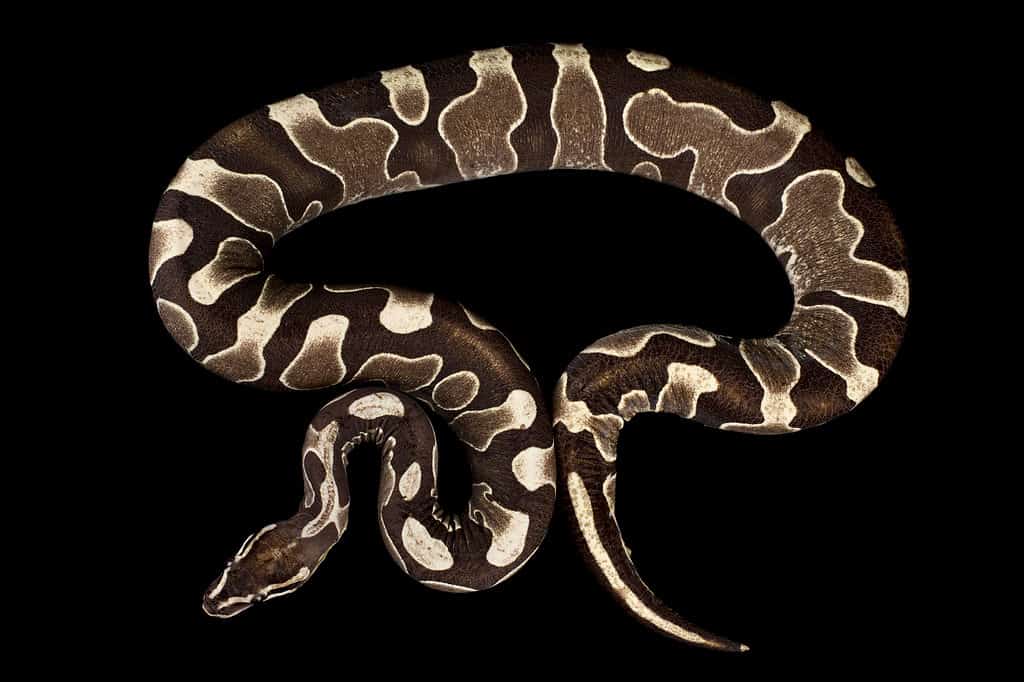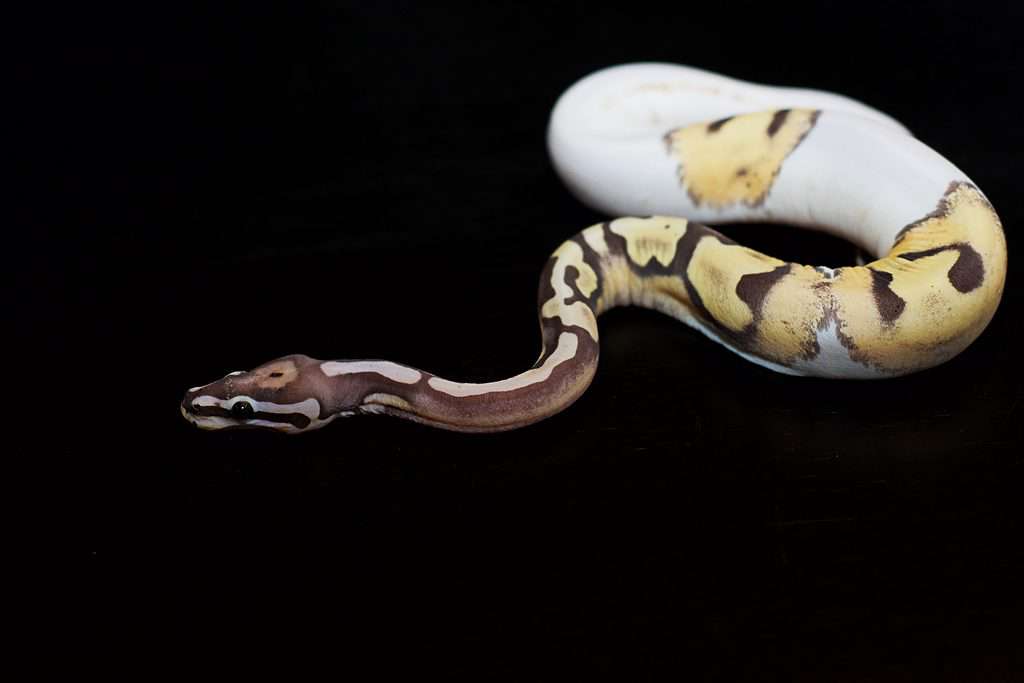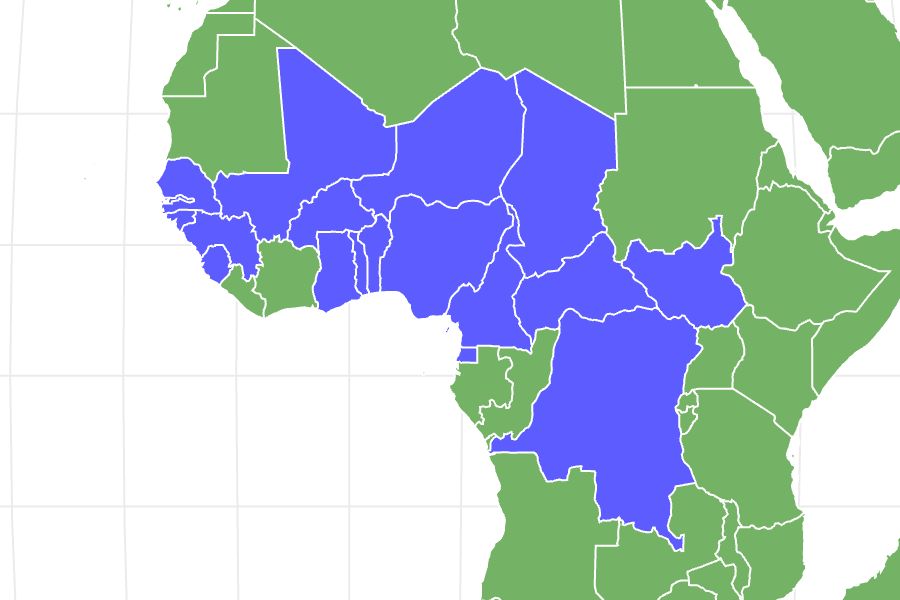Scaleless Ball Python
Python regius
Aside from the ocular scales covering each of its eyes, the scaleless ball python's body is completely smooth.
Advertisement
Scaleless Ball Python Scientific Classification
- Kingdom
- Animalia
- Phylum
- Chordata
- Class
- Reptilia
- Order
- Squamata
- Family
- Pythonidae
- Genus
- Python
- Scientific Name
- Python regius
Read our Complete Guide to Classification of Animals.
Scaleless Ball Python Conservation Status
Scaleless Ball Python Facts
- Prey
- Rodents, birds, amphibians, fish
- Main Prey
- Small rodents
- Group Behavior
- Solitary
- Fun Fact
- Aside from the ocular scales covering each of its eyes, the scaleless ball python's body is completely smooth.
- Most Distinctive Feature
- Scaleless skin, more vibrant color and pattern
- Temperament
- Docile, curious, gentle, hardy
- Habitat
- Grasslands, savannas, forests
- Diet
- Carnivore
- Lifestyle
- Nocturnal
- Location
- Western and central Africa
View all of the Scaleless Ball Python images!
“A rather controversial morph due to its extra-sensitive skin, the scaleless ball python has completely smooth skin with no visible scales aside from the ones on its eyes.”
Scaleless ball pythons are, as their name suggests, entirely smooth-skinned from head to tail, save for a single ocular scale covering each eye. They lack the usual textured head and body scales of most other ball python morphs. This results in not only a change in the texture of the snake’s skin, but also a more sleek appearance overall. Additionally, the snake’s body pattern and coloration tends to be more vibrant and have higher contrast than that of morphs with scales.
While incredibly popular, the scaleless morph has also become somewhat controversial. This is because it has more sensitive skin than typical scaled ball pythons. As a result, it is common for scaleless ball pythons to develop skin issues. Such issues are particularly along the belly, including burns and difficulty shedding. However, many reptile owners note that, with proper care and extra attention to account for this skin sensitivity, they are overall just as healthy as most other morphs.
Most scaleless ball pythons have the same overall color and pattern as standard wild-type ball pythons. In recent years, though, breeders have developed more color variants to further highlight the morph’s vibrant, high-contrast appearance.
3 Amazing Scaleless Ball Python Facts!
- Scaleless ball pythons in the wild have been recorded. They are incredibly rare, though, due to the morph’s highly sensitive and vibrant skin. In general, scaleless snakes are not well-equipped for surviving in the wild.
- Even scaleless ball pythons actually do have just two scales on their bodies. They have one ocular scale to protect each eye from irritants like sand and dirt.
- High, consistent humidity and soft substrate are essential for scaleless ball pythons to shed properly in captivity. This is because they are more prone to cuts, burns, and bruises than other morphs.
Where to Find Scaleless Ball Pythons
The standard, “wild-type” ball python is native to Sub-Saharan Africa. It most commonly lives in western and central African countries such as Nigeria, Ghana, and Cameroon. An incredibly hardy reptile, it can thrive in a wide range of habitats and climates. However, it generally prefers warm, humid weather and mainly resides in savannas, grasslands, and sparse forests with open clearings near large bodies of water.
As we touched on briefly above, it’s extremely rare to find scaleless ball pythons living in the wild. Although most morphs can technically occur naturally, the scaleless variety is among the rarest of them all. Thanks to their soft, sensitive skin and more vibrant coloration, they are much more vulnerable to the elements and predation. This makes it incredibly rare for adult scaleless pythons to locate and breed with one another in a non-controlled setting.
Despite being a fairly new morph, scaleless ball pythons have quickly become very popular amongst reptile keepers. However, because they are quite complicated to breed, they are also one of the more expensive morphs on the market.
If you’re interested in buying a scaleless ball python, you can expect to pay at least $1,500 or so for a single snake due to their rarity. Many unique color variants like the scaleless pinstripe, piebald, and Mojave can cost well into the thousands or even over $10,000 in some cases.
Scaleless Ball Python Scientific Name
All ball python morphs, including the scaleless morph, belong to the same species and are not classified into distinct subspecies. Because of this, they all share the same taxonomic classification and scientific name: Python regius, or “royal python.”
Notably, the ball python’s rather regal scientific name is likely thanks to its docile and hardy nature. Ancient Egyptian royals were often recorded and depicted draping live snakes around their wrists and necks as fashion accessories. Ball pythons are modest in size and tolerate handling. Because of that, important figures like Cleopatra likely “wore” them to flaunt their wealth and social status.
Scaleless Ball Python Population and Conservation Status
The ball python has been classified as near-threatened by the IUCN Red List since 2012.
Extinction is not currently an imminent threat to the species. Despite that, its native populations across much of central and western Africa have declined slightly in recent years.
Several key threats have contributed to the species’ diminishing numbers, most notably Africa’s agricultural and logging industries. Habitat loss due to deforestation is becoming increasingly common. Ball pythons are also vulnerable to the exotic pet trade and are sometimes also hunted and sold for food.
Although scaleless pythons can technically exist in the wild, they are extremely rare. Due to their vibrant skin and lack of protective scales, they are at an increased risk of predation, skin issues, and difficulty shedding properly. Currently, no data exists on this particular morph’s numbers in the wild.
How to Identify Scaleless Ball Python: Appearance and Description
The scaleless ball python morph is achieved by breeding two scaleless head morph ball pythons together. Scaleless head ball pythons, as their name implies, lack scales mainly on and around their heads. This is why the scaleless morph is also sometimes referred to by reptile breeders as the super scaleless head morph.
While the scaleless morph’s color and pattern can vary wildly, identifying a scaleless python is fairly straightforward thanks to their distinct skin texture and appearance. Rather than having textured, bumpy skin accented by lots of small, interlocking scales, the scaleless morph’s skin is entirely smooth from head to tail. Even the ventral or belly scales are absent. The only scales present on the snake’s entire body are two small ocular scales on each eye.
Additionally, due to its super-smooth skin, the morph’s color and patterning tend to be especially bold and bright. Reptile breeders have developed many specific color and pattern variations of the fully scaleless morph in recent years. These include the pastel, piebald, Enchi, and Mojave scaleless morphs.
To sum up, the scaleless morph is defined by these key traits:
- Entirely smooth skin from head to tail, aside from an ocular scale covering each eye
- More vibrant and well-defined color/patterning than scaled ball pythons
- Very soft texture to the skin overall
Scaleless Ball Python Evolution and History
The scaleless ball python morph is one of the more recent designer morphs to enter the reptile breeding scene. It was developed in 2013 by reptile breeder Brian Barczyk at BHB Enterprises.
However, the scaleless morph technically first emerged in 2010, when BHB Enterprises developed and bred snakes with the scaleless head gene. These ball pythons had smooth heads with no scales aside from the ocular scales covering each eye. However, the majority of the rest of the snakes’ bodies were covered in typical scales.
Barczyk and BHB Enterprises developed and popularized the fully scaleless morph around three years after the scaleless head morph’s initial success. By carefully breeding pythons with the scaleless head gene together, it became possible for them to create fully scaleless babies. Many other scaleless morphs of varying colors and patterns emerged over the following years. These include the scaleless pinstripe, pastel, and pied morphs.
Scaleless Ball Python Pictures

Scaleless ball pythons are similar to other ball python morphs; however, they are completely scaleless, except for a single scale above each eye.
©reptiles4all/Shutterstock.com

The scaleless morph is achieved by breeding two scaleless head ball pythons. They are easy to identify, due to their unique skin texture.
©Keung/Shutterstock.com
Scaleless Ball Python: How Dangerous Are They?
All ball python morphs generally share the same docile, gentle temperament, including the scaleless morph. Although they are constrictor snakes, they are one of the smallest, least aggressive members of the python family and are incapable of hunting animals much larger than an average rodent. In fact, the species’ common name, “ball” python, is a reference to its tendency to coil its body into a tight ball when threatened or startled.
Rather than being considered dangerous to humans, the ball python has become one of the most popular pet reptiles in the world! Its small size, cute appearance, and hardy, non-aggressive nature have made it a favorite amongst beginner and expert reptile enthusiasts alike.
It is worth noting, however, that the scaleless morph in particular is slightly more fragile than other varieties due to its uniquely textured and sensitive skin. Some pet owners note snakes of this particular morph can initially be somewhat more fearful and resistant to handling.
Scaleless Ball Python Behavior and Humans
As detailed above, the ball python’s uniquely gentle, inquisitive temperament has significantly contributed to its popularity in the exotic pet trade. Additionally, its small size and manageable care requirements make it an accessible and rewarding pet for both beginner and expert reptile keepers.
While many snake species commonly kept as pets are challenging or even dangerous to handle directly, the ball python is both hardy and calm enough to tolerate and even enjoy small amounts of human interaction. Still, early and consistent socialization whenever possible are essential to gradually and gently acclimate the snake to handling.
Since the mid-1990s, reptile breeders all around the world have developed more than 4,000 unique ball python morphs. The scaleless variety in particular is one of the few morphs that affects not only the snake’s patterning and coloration but also its skin texture. However, because their skin is also more sensitive than that of other morphs, babies and juveniles can be more timid and resistant to handling.
Related Animals…
View all 293 animals that start with SScaleless Ball Python FAQs (Frequently Asked Questions)
Are scaleless ball pythons venomous?
Ball pythons, regardless of the morph, are not venomous. All members of the python family are constrictor snakes that do not need to rely on venom to take down their prey.
How do scaleless ball pythons hunt?
Most python species, including the ball python, hunt in a similar fashion: stalking their prey quietly from a distance and ambushing them at the right moment. After latching onto their prey with their teeth, a ball python will quickly coil their entire body around the animal and tighten their muscles until the prey suffocates. After killing their prey, the snake then typically swallows the animal whole.
Are scaleless ball pythons aggressive?
All ball python morphs share a similarly gentle yet timid temperament. In general, they are not considered to be aggressive. In fact, some scaleless ball pythons are slightly more skittish than usual due to their extra-sensitive skin compared to that of other morphs with scales.
Where do scaleless ball pythons live?
Virtually all scaleless ball pythons are born and bred in captivity. While, like most morphs, they can technically be born outside of captivity, this is extremely rare. Furthermore, their sensitive yet vibrant skin makes them more vulnerable to predators.
What do scaleless ball pythons eat?
All ball python morphs are fully carnivorous. They prey on a wide range of small animals, primarily rodents, birds, and amphibians. Additionally, depending on their proximity to water, they will sometimes hunt small fish. In captivity, most reptile owners feed their ball pythons captive-bred “feeder” mice and rats.
Do scaleless ball pythons have health issues?
The scaleless morph is somewhat controversial due to its sensitive skin. Without the usual protective scales, the morph’s skin is more prone to health issues like burns, cuts, abrasions, bruises, and difficulty shedding properly.
It is essential for pet owners to regularly assess their scaleless ball pythons’ skin in captivity for any irregularities and alert a veterinarian of any sudden changes. With proper care and careful attention to enclosure temperatures and humidity, most thrive in captivity and have similar lifespans and outcomes to their scaled counterparts.
How much do scaleless ball pythons cost?
Because it is a more recent designer morph that can be quite challenging to breed in captivity, the scaleless variety tends to be one of the most expensive. Prices can vary significantly from $1,500 to $10,000 depending on the snake’s exact color, pattern, and traits.
Are scaleless ball pythons rare?
Yes, they are fairly rare in the exotic pet trade due to being extremely rare in the wild and difficult to breed in captivity. Additionally, their sensitive, scaleless skin requires slightly more specialized care than most other morphs. Finally, they tend to be in consistently high demand thanks to their distinct, visually striking appearance.
Thank you for reading! Have some feedback for us? Contact the AZ Animals editorial team.
Sources
- BHB Reptiles, Available here: https://www.bhbreptiles.com/pages/about-us
- IUCN Red List, Available here: https://www.iucnredlist.org/species/177562/15340592
- Morph Market, Available here: https://www.morphmarket.com/morphpedia/ball-pythons/scaleless-head/
- San Diego Zoo, Available here: https://animals.sandiegozoo.org/animals/python
- World of Ball Pythons, Available here: https://www.worldofballpythons.com/morphs/scaleless/

















